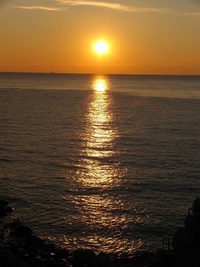كيف يعمل التصوير الفوتوغرافي
صفحة 1 من اصل 1
 كيف يعمل التصوير الفوتوغرافي
كيف يعمل التصوير الفوتوغرافي
Exactly how Photography Works: More, Lenses, and Cameras Explained
Confused by which electronic SLR you've, and most of the photography jargon which goes together with it? Check out some photography basics, find out how the camera of yours works, and just how that will help you are taking better pictures.
Photography has everything to do together with the science of optics - just how lightweight reacts when it's refracted, bent, and taken by photosensitive components, including photographic film or maybe photosensors in contemporary digital camera models. Master these fundamentals of exactly how a digital camera - practically any digicam - functions, which means you are able to enhance the photography of yours, whether you are going with an SLR, or maybe a mobile phone camera being the job done.
Only What's a Camera?
Camera_obscura_1
Roughly 400BC to 300BC, old philosophers of much more scientifically complex countries (such as China and Greece) had been several of the very first individuals to experiment with the camera obscura layout for producing pictures. The thought is easy enough - create a sufficiently black room with just a small little light entering by way of a a pinhole opposite a flat plane. The light journeys in lines that are straight (this experiment was utilized to confirm this), crosses at the pinhole, and make a picture on the flat airplane on the opposite side. The effect is an upside down model of the items being beamed in out of the exact opposite aspect of the pinhole - an amazing miracle, and an incredible scientific finding for people who existed much more when compared to a millennium prior to the "middle ages."
1000px-Pinhole_camera-en.svg
In order to understand contemporary digital cameras, we are able to begin with the camera obscura, leap ahead a couple of 1000 years, and start discussing the very first pinhole cameras. These use this exact same basic "pinprick" of mild idea, and make a picture on a plane of photosensitive content - an emulsified floor which reacts chemically when struck by lighting. Consequently the fundamental concept of any digital camera is gathering casual, and capture it on some sort of photosensitive object - film, in the situation of more mature cams, along with image sensors, in true of electronic ones.
Does Anything Go Faster Than the pace of Light?
sun_parts_big
The question posed above is kind of a technique. We all know from physics which the pace of light in a vacuum is a frequent, a speed limit that's not possible to pass. Nevertheless, light has an interesting property, as compared to various other particles, like neutrinos which travel at such fast speeds - it does not go exactly the same speed with every material. It slows, or refracts, bends, changing attributes as it goes. The "speed of light" escaping out of the middle of a thick sunshine is agonizingly sluggish in comparison to the neutrinos which get rid of them. Light usually takes millennia to escape a star's center, while neutrinos developed by a star react with almost nothing, then fly with probably the densest issue during 186,282 miles/sec, like it had been rarely even there. "That's most well and also good," you may ask, "but what does this must do with my camera?"
Galileantelescope
It's this same property of light to respond with material that permits us to twist, refract, and concentrate it utilizing contemporary photographic lenses. The same basic design has not changed in a few years, and also the same basic principles from once the first lenses are created apply now, also.
Focal Length and Staying in Focus 1000px-Focal-length.svg
While they've be complicated through the years, lenses are generally easy objects - portions of glass that refract light and point it toward a picture airplane toward the rear of the digital camera. Based on the way the cup in the lens is formed, the quantity of distance the crisscrossing light must converge correctly on the picture plane differs. Contemporary lenses are assessed in milimeters and refer to this particular level of distance in between the lens along with the convergence point on the picture airplane.
Focal length additionally affects the image type the camera captures of yours, too. A really light focal length is going to allow a photographer to catch a broader area of view, while an extremely long focal length (say, a telephoto lens) will reduce the spot you are imaging down to a significantly lesser window.
You will find three standard types of lenses for regular SLR images. They're [URL="https://www.picturepeople.ae/blog/just-what-does-a-photographer-do/"]Normal[/URL] lenses, Telephoto lenses, and Wide angle lenses. All these, beyond what has been talked about here, have various other caveats that come together with the use of theirs.
Konica_FT-1
Wide-angle lenses have great, 60+ degree angles of view, and therefore are typically worn for concentrating on item closer to the photographer. Items in angle lenses that are wide may seem distorted, in addition to misrepresenting the distances between distance items as well as skewing perspective at better distances.
Typical lenses are all those that most strongly represent the "natural" imaging much like how much the human eye captures. Angle of view is smaller compared to Wide angle lenses, with no distortion of items, ranges between objects, and perspective.
Long-focus lenses will be the large lenses you notice photography aficionados lugging about, and therefore are used-to magnify objects at good distances. They've the best narrow perspective of view, and therefore are usually utilized to produce depth of field shots as well as shots wherein background pictures are blurred, leaving foreground objects remain clear.
Based on the format utilized for photography, focal lengths for Normal, Wide Angle, along with Long Focus lenses improvements. Many standard digital camera models make use of a format much like the 35mm film cameras, therefore the focal lengths of contemporary DSLRs are much like the movie cameras of yesteryear (and nowadays, because the film photography buffs).
Shutter and aperture Speeds Because we all know that light has an obvious speed, just a limited quantity of it's present once you have a photo, and just a portion of which causes it to be through the lens on the photosensitive substances within. The amount of light is managed by 2 of the main tools a photographer is able to adjust - the aperture as well as shutter speed.
1000px-Aperture_diagram.svg
The aperture of a digital camera is akin to the pupil of the eye of yours. It's about an easy hole, which opens large or closes down firmly to enable more or less light with the lens on the picture receptors. Dazzling, well lit scenes require little light, therefore the aperture could be set to a bigger quantity to enable much less light through. Dimmer scenes demand far more light to strike the picture sensors in the digital camera, therefore the smaller number setting enables much more light through. Each setting, generally called f number, or stop, f-stop, generally allows half the quantity of light as the environment before it. Depth of field also changes with the f number configurations, raising the smaller the aperture utilized in the [URL="https://www.picturepeople.ae/blog/nine-benefits-that-are-amazing-of-photography/"]photograph.[/URL]
Besides the aperture environment, the quantity of time the shutter stays open (aka, shutter speed) to let light to hit photosensitive components may additionally be modified. Longer exposures allow in even more light, very helpful in dim lighting scenarios, but making the shutter open for lengthy periods of time is able to create big disparities in the photography of yours. Techniques as tiny as involuntary hand tremors could significantly blur the pictures of yours at slow shutter speeds, necessitating the usage of robust airplane or a tripod to put the digital camera on.
800px-Windflower-05237-nevit
Utilized in tandem, slower shutter speeds are able to compensate for smaller configurations in aperture and huge aperture openings compensating for extremely fast shutter speeds. Every blend is able to provide a really different outcome - making it possible for a lot of light in after a while is able to make a really different picture, compared to allowing a lot of light in via a bigger opening. The resulting blend of shutter speed in addition to aperture generates an "exposure," or maybe the entire quantity of light which strikes the photosensitive components, be [URL="https://www.picturepeople.ae/blog/how-you-can-take-pictures-that-are-good/"]they film[/URL] or sensors.

ابراهيم كمال-

- عدد المساهمات : 1989
العمر : 44
نقاط تحت التجربة : 9528
تاريخ التسجيل : 03/01/2020
 مواضيع مماثلة
مواضيع مماثلة» خدمات التصوير الفوتوغرافي
» الي باش يعمل طلة على امريكا يمشي يعمل نظرة على اغرب بحيرة في العالم
» دقّة وفن في التصوير
» أهم ماكينات التصوير وأنواعها وأسعارها
» ضربه مباشره
» الي باش يعمل طلة على امريكا يمشي يعمل نظرة على اغرب بحيرة في العالم
» دقّة وفن في التصوير
» أهم ماكينات التصوير وأنواعها وأسعارها
» ضربه مباشره
صفحة 1 من اصل 1
صلاحيات هذا المنتدى:
لاتستطيع الرد على المواضيع في هذا المنتدى




